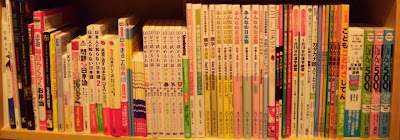
This is a little off topic, but I feel it's important for anyone who is a fan of the advancement of technology in Japan. 携帯電話 or simply 携帯 (keitai) is japanese for cellphone, and everybody knows their cellphone is way better then anything else in the world. Their cellphone have better cameras(low light sensitive, 12Mpixel, face reg...), uses Felica(A near-field communication) letting their phone act as their wallet. There are also other random features from figerprint scanner, waterproofed, to 3D movies. But there are also disadvantages to these keitais, like their strict content control(files being locked onto a UIM or must be downloaded thru their network and not USB) and sometimes confusing filing/naming system.
Right now, I'm using a nttDOCOMO SH-01B keitai (Black) by sharp in Toronto, Canada. Since technically, they were not meant to be used here, there are functions that will not work here, and the reception sucks depending where you are and which Hypersim you're using. A Hypersim is a print circuit board on a thin film that overlays on top of your SIM, which tricks the keitai into thinking that it's a UIM. But there are times you'll get an out of signal not because there's no signal, but the keitai is not talking to the SIM, so depending on your Hypersim stability, and if it has auto-recovery, the signal varies. Also, the battery life sucks on keitais....usually, it'll literally last only for a day, 24 hours. One of the things I found was that if you can, switch over to 3G rather than GSM to save battery, and turn off before you sleep and set it to auto-wake in the morning is a life saver.
The restrictions on a keitai is usually no GPS, since it uses A-GPS, which depends on the carrier, Internet, since they don't use chtml(i think), but a properitatery format known as i-mode. No NFC, 1-seg (unless you're in Brazil), simply put is satillite TV, WiFi (only selected models have it) and these are the major ones that I remember off the top of my head. Oh, and the carrier is also important, because out of the three major carriers (au kddi, nttDOCOMO, softbank) au kddi uses CMDA so it won't work here, softbank will have a media-lock on the phones so when you start the phone up, I'll need to get a confirmation from the carrier to unlock functions like camera, so if it loses signal, you're basically screwed. nttDOCOMO is the easiest, just need a hypersim and usually it's fine.
Anyway, I mentioned keitai is because the all of the phone made by Sharp have a built-in dictionaries,( eng-jap, jap-eng, and jap-jap ), while others have appli that requires the internet to look up words. But it's kinda limited, but it's better than nothing when I'm not at home and want to look up a word.

